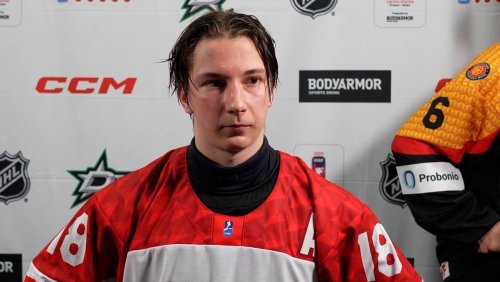.jpg.781498e90f681f71ced92669c5ec512d.jpg)
Jake Middleton has established himself as one of the Minnesota Wild’s most likable players. His toothless grin, bombastic mustache, and blue-collar upbringing call to mind memories of a bygone era of hard-nosed hockey. He’s charismatic on camera and endeared himself further to the entire State of Hockey with a dig at Edina in a feature in The Athletic.
“I don’t think I’m (going to) Cake Eater country just yet,” he joked. “That’s not my speed yet. We’ll see. But not anytime soon.”
His striking appearance and physical on-ice style combine with that charisma to make Middleton something of a modern enforcer. He’s the type of player that makes fans and teammates glad he’s on their side.
So why did people meet his extension with groans?
It’s not hard to find analysts and blog posts criticizing the front office for this move. There’s no need to rehash it here: public consensus is that while Middleton is an effective bottom-four defenseman, the Wild overpaid him on his new extension. Furthermore, the timing of this move makes little sense, given that Middleton is 28 years old and under contract for the 2024-25 season. With no pressure to retain him, why would Minnesota feel urgency to sign him to an extension -- least of all at this number?
That’s enough for some people to conclude that the front office had made a massive mistake by signing this extension – and perhaps those people are correct. However, for the curious mind, why? is not an incredulous remark but the beginning of a beautiful journey.
To answer that why, I started with an interesting piece of reporting from The Athletic’s Michael Russo: “Middleton played through injuries this past season himself, including a knee that had to be cleaned up after the season.”
Could that injury be the key to explaining this whole extension?
What comes next will require some speculation about what it means to “clean up a knee.” Please note that I am not reporting the nature of Middleton surgery because I do not have any new information to share. Based on Russo's wording in his report, I am simply speculating about the nature of that procedure.
Taking that leap in logic, it sounds like the procedure involves the removal of something from the knee. That could include a meniscus trim or repair. That hypothesis is also supported by the report that Middleton played through injury before the procedure, as is possible with meniscus injuries. It doesn’t prove that Middleton had a meniscus injury, but it’s possible.
It’s worth continuing down that rabbit hole, even with several degrees of uncertainty, because a meniscus procedure would explain a lot about Middleton’s extension.
There are two common procedures for treating an injured meniscus: a full repair and a meniscectomy (or a “trim”). The trim simply removes the damaged portion of the meniscus. It’s minimally invasive, and many professional athletes elect this procedure for its short recovery timeline. They can typically return to athletic activity in a month or two.
The repair has a longer recovery timeline: “Jogging typically begins around three to four months with return to sports around six to nine months.” The tradeoff is that a repair has better outcomes concerning strength, stability, and pain in the knee. These are crucial to the performance and future health of a player like Middleton, who the Wild often task with boxing out opponents at the net.
When a professional hockey player has the option to return to play sooner but work through more pain, that’s going to sound pretty familiar. Aside from the daily workout schedule, Middleton is no stranger to cross-checks, slashes, and blocking 90 MPH slap shots. But get him back on the ice sooner, and he’ll do it enthusiastically. So, perhaps he opted for the meniscus trim.
On the other hand, why would the team commit to Middleton this summer after a procedure like that? What if Middleton opted for the full repair, and they offered the extension after a successful surgery?
Middleton should be ready for the beginning of the season; the team hasn’t indicated otherwise. But with an aggressive timeline, Middleton could return to skating six months after surgery. If the procedure happened just after the season ended on April 18, he could be eyeing a return to the ice right around the October 10 season opener.
Steven Stamkos had a meniscus surgery in November 2016. It was presumably a full repair, given that it kept him out for the rest of the season; a trim would have allowed him to return before springtime. After that procedure, he never regained the breakneck scoring pace of his younger years, but he still played at an elite level.

Steven Stamkos career statistics, courtesy of Hockey Reference
Stamkos played a full load of games and minutes the year after his procedure but scored at a lower rate than his rookie season. The long recovery timeline may have played a part in his decreased production. Notably, he had one of the best seasons of his career the following year in 2018-19.
Stamkos also missed games due to injury in the 2019-20 and 2020-21 seasons. However, some of that was related to a core muscle injury. The team also termed some of it a “lower-body injury,” which may have been related to his meniscus. When he was healthy in those seasons, he scored at his usual elite rate or just below it.
If Middleton’s recovery follows this timeline, the four-year extension makes more sense. It also explains the contract’s timing. If Middleton returns to his second-pair form by the end of 2024-25, the whole league will know he’s back. He would then hit the open market, which could increase his price. By extending him this summer, the Wild are taking advantage of their trainers’ knowledge of Middleton’s outlook. In exchange, Middleton gets security.
That explains the term and the timing, but does it explain the price? Some of the $4.35 Average Annual Value (AAV) can be chalked up to Middleton’s locker room presence and veteran leadership. However, the AAV is well above his projected on-ice value from most publicly available models. As cool as Middleton is, surely Bill Guerin isn’t throwing in an extra $3 million annually for it.
Take a look at Dom Luszczyszyn’s contract value graphic below. Russo has reported that Middleton’s performance was marred by injury, but this model does not quantify how much injury hampered Middleton’s 2023-24 performance. Some of that is baked in because it predicts age-related decline, which is often related to injury. The model projects a significant dropoff in 2024-25, which could be accurate if Middleton needs time to ramp up to full strength.
However, if Middleton is poised for a bounce-back in the second year after his surgery (like Stamkos), he could reverse the aging curve in that season (2025-26) and the years after. Those are the years that this extension covers. If Middleton returns closer to his pre-injury performance, his 2022-23 performance is a better benchmark for those years. In that season, his on-ice value was near $5 million. In that scenario, he could live up to the full value of this extension in three or even all four years of the deal.
Add in his veteran leadership and some cap inflation, and it actually presents a scenario for Minnesota to come out ahead on this deal. However, it’s an unlikely situation. 28-year-old defensemen don’t usually return from injury at 100% of their pre-injury value because even healthy players in their late 20s typically don’t play at the same level as they did two years ago.

Based on research courtesy of HockeyViz.com
None of this makes the contract a great deal for the Wild. Still, it’s a much more reasonable analysis than looking at the deal and concluding, Man, Minnesota really stepped in it this time. Even if the deal is somewhat inefficient over its lifetime, that’s extremely common for veteran contracts in the NHL. Front offices must spend their money somewhere, and ELC and RFA deals nearly always favor the team.
On the negative side, remember that it took a few assumptions to get here. For example, we don’t know if Middleton’s injury was related to the meniscus. That’s mostly conjecture based on the wording of Russo’s report. It’s also still fair to criticize this move in light of the need to make room for younger players to join the NHL club. However, Minnesota’s defense prospects still have the opportunity to compete with players like Declan Chisholm. Middleton can also slide to the third pairing in the final years of this extension if those prospects grow into a second-pairing role.
There’s not much left to do, but watch and see how the deal plays out. In the words of another charismatic professional athlete, “Hate me or love me, you watched. And that’s all that you could do.”
Ultimately, I’m glad we get to love Jake Middleton for another four years. And if we hate the contract, there may not be a better guy the Wild could overpay.
Think you could write a story like this? Hockey Wilderness wants you to develop your voice, find an audience, and we'll pay you to do it. Just fill out this form.
-
 1
1
-
 1
1






Recommended Comments
Join the conversation
You can post now and register later. If you have an account, sign in now to post with your account.
Note: Your post will require moderator approval before it will be visible.